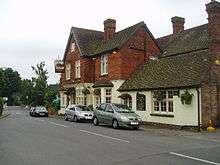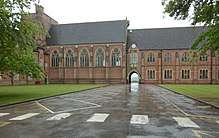Ardingly
Ardingly (/ˈɑːrdɪŋlaɪ/ AR-ding-lye) is an English village and civil parish in the Mid Sussex district of West Sussex, England. The village is in the High Weald Area of Outstanding Natural Beauty about 33 miles (53 km) south of London and 33 miles (53 km) east-north-east of the county town of Chichester. The parish covers an area of 3,974 acres (1,608 ha). The 2011 Census recorded a population of 1,936[2] an increase from 1,833 in 2001.
| Ardingly | |
|---|---|
St. Peter's Parish Church | |
 Ardingly Location within West Sussex | |
| Area | 16.09 km2 (6.21 sq mi) [1] |
| Population | 1,833 [1] 2001 Census 1,936 (2011 Census)[2] |
| • Density | 114/km2 (300/sq mi) |
| OS grid reference | TQ3429 |
| • London | 31 miles (50 km) N |
| Civil parish |
|
| District |
|
| Shire county | |
| Region | |
| Country | England |
| Sovereign state | United Kingdom |
| Post town | Haywards Heath |
| Postcode district | RH17 |
| Dialling code | 01444 |
| Police | Sussex |
| Fire | West Sussex |
| Ambulance | South East Coast |
| UK Parliament | |
| Website | Ardingly Parish Council |
Heritage
There is mention of a place spelt as Ertlyngeleghe, in 1396, which may refer to Ardingly.[3]
St Peter's parish church, towards the western end of the village, dates from the 14th century.
Kew's wild botanic garden, Wakehurst (previously known as Wakehurst Place) is about 1.5 miles (2.4 km) north of the village. Ardingly Reservoir is about 1 mile (1.6 km) west of the village. The Big-Upon-Little rock formation is close to a footpath between Ardingly and West Hoathly.
Events
In June the South of England Agricultural Show early in the month and the London to Brighton cycle event (usually held on Father's Day) attract visitors from a wide area. The South of England Showground hosts regular antiques fairs, some of which have featured on the BBC Television game show Bargain Hunt.
Every four years an international Scout camp is held on the showground, attended by about 3,000 Scouts and Girl Guides from West Sussex and other areas at home and abroad. The most recent event, WS 2017, was held on 5–12 August 2017. The next WS event, 2021 is being planned for 7–14 August 2021.
Schools
At the southern edge of the village is Ardingly College, an independent school. The village also has a Church of England primary school, St. Peters CE Primary, with about 120 pupils. Most of the children of secondary-school age attend Oathall Community College in Haywards Heath.
Public transport

Ardingly has a low-frequency bus service to the nearby towns of Haywards Heath and Crawley.
Ardingly railway station was opened 1 October 1864 by the London, Brighton and South Coast Railway.[4] The Southern Railway electrified the line in the 1930s but British Railways closed the line and station to passenger trains in 1963.[4] The goods yard and connection to the main line remain open as an ARC Aggregates terminal.[4] The nearby Bluebell Railway owns the former trackbed between Ardingly and Horsted Keynes and has a long-term aspiration to re-open the line.[4]
Notable people
- Frances Garnet Wolseley, 2nd Viscountess Wolseley, a celebrated horticulturist and gardening author, moved to Culpepers, Ardingly, in 1920 and died there in 1936.[5]
- Jon Snow, journalist and television presenter, was born in Ardingly in 1947.[6]
References
- "2001 Census: West Sussex – Population by Parish" (PDF). West Sussex County Council. Archived from the original (PDF) on 8 June 2011. Retrieved 1 April 2009.
- "Civil Parish population 2011". Neighbourhood Statistics. Office for National Statistics. Retrieved 27 September 2016.
- Plea Rolls of the Court of Common Pleas; National Archives CP40/541; ; 6th entry – the defendant Richard atte Lynde appears as an MP for Horsham in 1402.
- Ardingly railway station on Disused-Stations.org.uk - Nick Catford - Accessed 9 September 2007
- Jane Brown, "Wolseley, Frances Garnet, Viscountess Wolseley (1872–1936)", Oxford Dictionary of National Biography (Oxford, UK: OUP, 2004). Retrieved 27 December 2016. Pay-walled.
- "News items: Jon Snow". University of Sussex. Retrieved 20 July 2015.
Further reading
- Pevsner, Nikolaus; Nairn, Ian (1966). The Buildings of England: Sussex. Harmondsworth: Penguin Books. ISBN 0-300-09677-1.
- Salzman, L.F. (1940). Victoria County History: A History of the County of Sussex, Volume 7: The Rape of Lewes. pp. 127–132.
